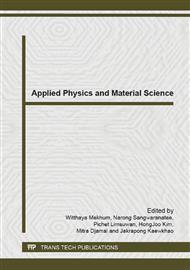[1]
C. Bootjomchai, J. Laopaiboon, C. Yenchai, R. Laopaiboon, Gamma-ray shielding and structural properties of barium–bismuth–borosilicate glasses, Rad. Phys. Chem. 81 (2012) 785–790.
DOI: 10.1016/j.radphyschem.2012.01.049
Google Scholar
[2]
S. Sindhu, S. Sanghi, V.P. Seth and A. Agarwal, Theoretical Optical basiscity and third order nonlinear optical susceptibility in 20MO. xBi2O3. (80-x)B2O3 (M=Ca, Ba, Sr) Glass system, Proceedings of the golden jubilee DAE-BRNS national laser symposium (NLS - 2003). Allied Publishers, New Delhi, 2003, p.411.
Google Scholar
[3]
D. W. Hall, M. A. Newhouse, N. F. Borelli, W. H. Dumbaugh, D. L. Weidman, Nonlinear optical susceptibilities of highindex glasses, Appl. Phys. Lett. 54 (1989) 1293–1295.
DOI: 10.1063/1.100697
Google Scholar
[4]
C. Stehle, C. Vira, D. Hogan, S. Feller, M. Affatigato, Optical and physical properties of bismuth borate glasses related to structure, Phys. Chem. Glasses. 39 (1998) 83–86.
Google Scholar
[5]
A. Panand, A. Ghosh, New family of lead-bismuthate glass with a large transmitting window, J. Non-Cryst. Solids. 271 (2000) 157–161.
DOI: 10.1016/s0022-3093(00)00111-3
Google Scholar
[6]
D. Rajesh, Y.C. Ratnakaram, M. Seshadri, A. Balakrishna, T.S. Krishna, Structural and luminescence properties of Dy3+ ion in strontium lithium bismuth borate glasses, J. Lumin. 132 (2012) 841–849.
DOI: 10.1016/j.jlumin.2011.08.050
Google Scholar
[7]
K. Madhukamar, H.K. Varma, M. Komath, T.S. Elias, V. Padmanabhan, C.M.K. Nair, Photoluminescence and thermoluminescence properties of tricalcium phosphate phosphors doped with dysprosium and europium, Bull. Mater. Sci. 30 (2007) 527–534.
DOI: 10.1007/s12034-007-0082-x
Google Scholar
[8]
A. Joseph, G.L. Praveen, K. Abha, G.M. Lekha, S. George, Photoluminescence study on amino functionalized dysprosium oxide–zinc oxide composite bifunctional nanoparticles, J. Lumin. 132 (2012) 1999–(2004).
DOI: 10.1016/j.jlumin.2012.03.023
Google Scholar
[9]
P. Babu, K. H. Jang, E. S. Kim, L. Shi, H. J. Seo, Optical Properties and white-light emission in Dy3+-doped transparent oxyfluoride glass and glass ceramics containing CaF2 nanocrystals, J. Korean Phys. Soc. 54 (2009) 1488–1491.
DOI: 10.3938/jkps.54.1488
Google Scholar
[10]
T. Suzuki, M. Hirano, H. Hosono, Optical gaps of alkali borate and alkali fluoroborate glasses, J. Applied Phys. 91 (2002) 4149–4153.
DOI: 10.1063/1.1456946
Google Scholar
[11]
G. Lakshminarayana and J. Qiu, Photoluminescence of Pr3+, Sm3+ and Dy3+: SiO2–Al2O3–LiF–GdF3 glass ceramics and Sm3+, Dy3+: GeO2–B2O3–ZnO–LaF3 glasses, Physica B, 404 (2009) 1169–1180.
DOI: 10.1016/j.physb.2008.11.083
Google Scholar
[12]
Y.C. Li, Y.H. Chang, Y.F. Lin, Y.S. Chang, Y.J. Lin, Synthesis and luminescent properties of Ln3+ (Eu3+, Sm3+, Dy3+)-doped lanthanum aluminum germanate LaAlGe2O7 phosphors, J. Alloys Comp. 439 (2007) 367–375.
DOI: 10.1016/j.jallcom.2006.08.269
Google Scholar


